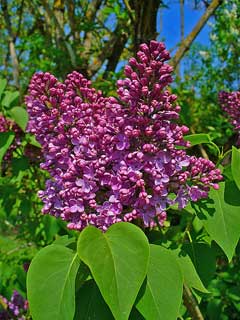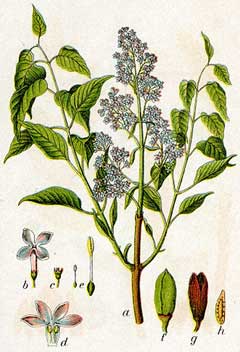 |
|
http://commons.wikimedia.org/wiki/User:Llez |
 |
| http://commons.wikimedia.org/wiki/File:Syringa_vulgaris_Sturm2.jpg |
Translate this page:
Summary
Bloom Color: Lavender, Pink, Purple, White. Main Bloom Time: Early spring, Late spring, Mid spring. Form: Rounded.
Physical Characteristics

 Syringa vulgaris is a deciduous Shrub growing to 6 m (19ft 8in) at a medium rate.
Syringa vulgaris is a deciduous Shrub growing to 6 m (19ft 8in) at a medium rate.
See above for USDA hardiness. It is hardy to UK zone 5. It is in flower in May, and the seeds ripen in August. The species is hermaphrodite (has both male and female organs) and is pollinated by Bees, Lepidoptera (Moths & Butterflies).
It is noted for attracting wildlife.
Suitable for: light (sandy), medium (loamy) and heavy (clay) soils and can grow in heavy clay soil. Suitable pH: neutral and basic (mildly alkaline) soils and can grow in very alkaline soils.
It cannot grow in the shade. It prefers moist soil.
UK Hardiness Map
US Hardiness Map
Synonyms
Plant Habitats
Woodland Garden Sunny Edge; Dappled Shade; Hedge;
Edible Uses
Edible Parts: Flowers
Edible Uses:
Flowers - raw or folded into batter and fried to make fritters[183].
References More on Edible Uses
Medicinal Uses
Plants For A Future can not take any responsibility for any adverse effects from the use of plants. Always seek advice from a professional before using a plant medicinally.
Antiperiodic Febrifuge Mouthwash Tonic Vermifuge
The leaves and the fruit are antiperiodic, febrifuge, tonic and vermifuge[4]. The bark or leaves have been chewed by children as a treatment for sore mouth[257].
References More on Medicinal Uses
The Bookshop: Edible Plant Books
Our Latest books on Perennial Plants For Food Forests and Permaculture Gardens in paperback or digital formats.

Edible Tropical Plants
Food Forest Plants for Hotter Conditions: 250+ Plants For Tropical Food Forests & Permaculture Gardens.
More

Edible Temperate Plants
Plants for Your Food Forest: 500 Plants for Temperate Food Forests & Permaculture Gardens.
More

More Books
PFAF have eight books available in paperback and digital formats. Browse the shop for more information.
Shop Now
Other Uses
Dye Essential Hedge Hedge Rootstock
An essential oil is obtained from the flowers. Used in perfumery[171]. A green dye is obtained from the flowers[168]. Green and brown dyes can be obtained from the leaves[168]. A yellow-orange dye is obtained from the twigs[168]. Plants can be grown as an informal hedge[200]. The plant is often used as a rootstock for the various ornamental cultivars of lilac. Its main disadvantage is that it can sucker very freely[200].
Special Uses
Attracts Wildlife Hedge Hedge Scented Plants
References More on Other Uses
Cultivation details
Landscape Uses:Border, Standard, Seashore, Specimen. Succeeds in most soils, including chalk, but dislikes acid soils[11]. Prefers a deep stiff well-drained loam in a warm sunny position[11, 200]. A very ornamental plant[1], it does tend to sucker quite freely though[200]. There are many named varieties, developed for their ornamental value[182]. The flowers attract butterflies and moths[30]. Plants in this genus are notably susceptible to honey fungus[200]. Special Features:
Not North American native, Fragrant flowers, Blooms are very showy.
References Carbon Farming Information and Carbon Sequestration Information
Temperature Converter
Type a value in the Celsius field to convert the value to Fahrenheit:
Fahrenheit:
The PFAF Bookshop
Plants For A Future have a number of books available in paperback and digital form. Book titles include Edible Plants, Edible Perennials, Edible Trees,Edible Shrubs, Woodland Gardening, and Temperate Food Forest Plants. Our new book is Food Forest Plants For Hotter Conditions (Tropical and Sub-Tropical).
Shop Now
Plant Propagation
Seed - sow March in a north facing cold frame. Pre-treating the seed with 4 weeks warm then 3 weeks cold stratification improves germination. It is probable that sowing the seed as soon as it is ripe in a cold frame would be a more reliable method[K]. Prick the seedlings out into individual pots once they are large enough to handle. Plant them out in the summer if sufficient growth has been made, otherwise grow them on in a cold frame for their first winter and plant out in late spring of the following year. Cuttings of young shoots, 7cm with a heel, June in a frame[200]. Cuttings of half-ripe wood, 7cm with a heel, July/August in a frame[200]. Layering in spring before new growth begins. Takes 12 months[78]. Division of suckers in late winter. They can be planted straight out into their permanent positions.
Other Names
If available other names are mentioned here
Native Range
EUROPE: Former Yugoslavia, Albania, Bulgaria, Greece, Romania
Weed Potential
Right plant wrong place. We are currently updating this section.
Please note that a plant may be invasive in one area but may not in your area so it’s worth checking.
Conservation Status
IUCN Red List of Threatened Plants Status :

Growth: S = slow M = medium F = fast. Soil: L = light (sandy) M = medium H = heavy (clay). pH: A = acid N = neutral B = basic (alkaline). Shade: F = full shade S = semi-shade N = no shade. Moisture: D = dry M = Moist We = wet Wa = water.
Expert comment
Author
L.
Botanical References
1150200
Links / References
For a list of references used on this page please go here
Readers comment